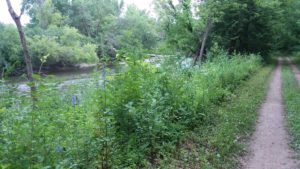
I started taking daily walks because my psychiatrist told me to. I was on one of the psych units at a hospital in Minneapolis. At our first meeting, the in-patient psychiatrist assigned to me said, “Bob, you’re burning up with adrenalin. You need some physical activity to burn it off.” It took a while before I was able to do other things he told me to do, but I starting taking walks the day after I was discharged. More than sixteen years later, I’m still at it.
If you are a daily walker like me, or a daily runner or biker, you probably have your favorite route. I live in St. Louis Park, a near western suburb of Minneapolis, and I have several, one of which brings me by a Trader Joes, where I can pick up some things for supper. But my favorite route isn’t in St. Louis Park; it’s in Northfield about a 40 mile drive southeast. Boasting “cows, colleges, and contentment”, Northfield is just a sweet place. I’ve had the privilege of serving the UCC church there in different pastoral roles, and I feel that the congregation always brought out the best in me as a minister and mostly overlooked the other stuff.
While living and working in Northfield, I discovered the path you see in the picture with this blog. It starts in the Cowling Arboretum of Carleton College, follows the Cannon River for quite a while, and then heads off into the woods. I’ve never gotten to the end of it. I walk it out and back, about half an hour one way and then turn around and come back. An hour is a good walk for me, time to burn off whatever adrenalin is trying to subvert my recovery.
Since I don’t live in Northfield anymore, walking this path means a drive there. Maybe my wife Susan will come with (Dialectical note: native Minnesotans like Susan say, “Come with.” They drop the direct object, as in “Come with me.” I make no judgment.) Maybe we’ll see some friends for lunch. Maybe there’s something fun going on at Carleton or St. Olaf. All good, but the best is always a walk on the path I love.
I begin with the goal of burning off adrenalin and end up just savoring the bliss of it all. After a while, unless it’s something really major, whatever is bothering me at the start of the walk drifts away. And once I’m into the walk, even the big things don’t matter so much. I relax, feel that I can cope, feel that step by step my soul is being restored.
In good part the walk brings me such bliss because it gets me out of my head, where intrusive thoughts and self-punitive scenarios remind me of my depression at it’s worse. Walking my favorite route, I’ve seen bald eagles and great blue herons fishing in the Cannon, indigo buntings flashing in the tall bushes, a flight of Monarchs, an eruption of wildflowers. With so much to draw me out of my head and into the world, the hour walk does more for my recovery than any hour of therapy has ever done
I love to see something unexpected in the woods. Maybe next time I’ll get a glimpse of the owl I heard on my last walk, but the bliss of my favorite walk doesn’t depend upon it. Its more about the place itself. After a while when I’m fully in the mood of the walk, I’m simply happy to be there. I’m reminded of the end of the book of Job. Like Job there’s so much I don’t understand, but walking along the river I’m just grateful to be part of it all, glad to be alive. Mental illness took this away from me. Walking along the Cannon River gives it back.

Bob Griggs
Ordained in 1973, Bob Griggs has served UCC churches in Massachusetts, New Hampshire, and Minnesota. He is an Advisory Council member at Vail Place, a club house for people living with mental illness. He is also the author of A Pelican of the Wilderness: Depression, Psalms, Ministry, and Movies and Recovering from Depression: Forty-Nine Helps.